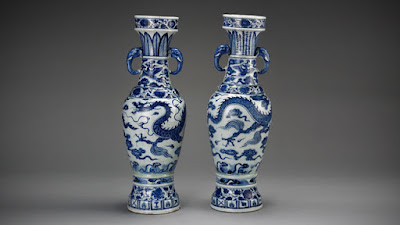Chinese Chinese Porcelain of the 18th C. Famille Rose, Blue and White
A Very Quick Refresher on the Origins of Porcelain Making and The West.
The history of porcelain in China is an exceptionally long one. The first known examples of "Proto Porcelains" have been discovered in kiln sites dating to the Eastern Han Dynasty in the province of Zhejiang around 1,000 BC. The shards and fragments contain Kaolin and were by their very content required to be fired in wood kilns at very high temperatures 1260 C to 1300 C., thus they are technically porcelain.
 |
| Pair of Blue and White Kangxi Period Soldier Vases |
From those humble, yet historic beginnings 3,000 years ago Chinese porcelain and pottery making evolved over and over through thousands of; kilns, varying experimental forms, clay and kaolin formulas, coupled with an un-countable number of applied decorations and glazes.
By the 17th C. Chinese porcelain was sought and coveted around the known world. Other than in perhaps China itself, porcelain was valued more in Europe than any place else.
A Case in Point
The aforementioned Augustus the Strong of Saxony (1670-1733) actually traded a full regiment of 600 equipped soldiers to King Fredrik I of Prussia for a group of 151 early Chinese Kangxi period porcelain pieces. Part of this transaction included enormously tall blue and white Kangxi vases and were subsequently named "Dragoon Vases" after the soldiers who were used as barter for their acquisition.
Originally this collection was sent to the west via the French Jesuit Missionary Pere d'Entrecolle then living in Jingdezhen through the British East India Company and presented to Queen Sophia Charlotte of Hanover (1668-1705) who was British, sister to King George I of England and married to King Fredrik I. Upon her death, Fredrik I traded them for soldiers "owned" by Augustus the Strong. Its a fascinating story and illustrates clearly how much value was placed on these objects.
 |
| Yuan Period Elephant Handle Vases David Foundation Collection |
Perfection of the 18th C. Porcelain
 |
| Pair of Kangxi Dragoon Vases, Fine Quality Blue and White |
Motifs and Shapes and Patterns
 |
| Fine Kangxi Period "Yen Yen" Vase, Circa 1700 Stong Cobalt Decoration |
The scenes and patterns used were drawn from all corners of Chinese art and history including religion, poetry, classical landscapes, interior domestic scenes, court scenes, eroticism, dragons, calligraphy, children playing, historic and epic events, battle scenes, gardens, flowers, insects and aquatic life. Yes its endless.
Famille Rose known as Yangcai or Foreign Colors or Fencai or Soft Colors enter China through the Jesuits
 |
| Yongzheng Period Famille Rose Dish |
Yongzheng (1723-1735)
 |
| Early Qianlong Period Export Porcelain |
Additionally the Yongzheng period saw a resurgence in making porcelains from models of the Ming period, in particular those of the Chenghua Period (1465-1487). They were even able to replicate the precise tone of the pieces, fine grained body, everted rim, these were as close to as exact copies as could be created. Doucai Chicken Chicken Cups were a particular favorite along with stem cups.
Hongli, The Qianlong Emperor (1735-1795)
Qianlong became the emperor of China at the age of 24 in 1735 following the death of his father Yongzheng. Like his grandfather Kangxi he was a patron of the arts and very liberal compared to his father.
 |
| Qianlong Period Export Goose Tureens, Famille Rose Decoration |
During his life he made massive additions to the "Yuan Ming Yuan" also know as The Old Summer Palace. Initially it was called "The Imperial Gardens" and was built by his grandfather Kangxi. Initially with a small palace but an incredibly elaborate series of gardens. Eventually the building evolved into looking like a French Palace on steroids under Qianlong's rule.
 |
| Late Qianlong Period Dinner Service |
From around the mid 1700's onward millions of pieces were produced and shipped for western gold and silver. Some were "stock patterns" others as were produced as custom services depicting Armorial wares with Crests and Coats of Arms of wealthy English, French, German, Spanish, Italian, Swedish, Dutch and Portuguese family's. Many orders comprised massive services of hundreds of pieces including a bewildering variety of tureens, covered bowls, chocolate pots, gravy boats, huge serving platters, punch bowls in some cases almost 3 feet wide. Yes of course they included tea pots, cups, saucers and tea caddies. Many examples were based on European silver forms, sometimes carved wooden models would be used as guides for the potters to follow.
 |
| Qianlong Period Famille Rose Court Ladies, Carrying Lotus Blossoms |
During the 18th C. the thousands of large dragon kilns operated, running day and night firing pieces for export as well as filling local demand and of course orders for the Imperial Court. In time, the finest of the export pieces were rivaling those for the Emperor in quality on all levels.
Custom pieces were also produced, porcelain figures of Dutch and English merchants, dancing figures, lavabo's, massive tureens, in the shape of full bodied Geese. The Peabody Essex Museum has one of the finest collections in the world of these pieces, along with the best China Trade Collection as well. Make a genuine effort to visit the PEM if you get to the Boston area, Salem is 40 Minutes from downtown Boston.
Toward the end of the 18th C. Trade with America began directly...and that's a whole other story.
Feel free to email or call with any questions about your own Chinese porcelains or their values.
Thank you for visiting ~ Peter Combs


Comments
Post a Comment
If you have any questions or comments please send us a message. Or use the Contact Us tab at the top of the page.